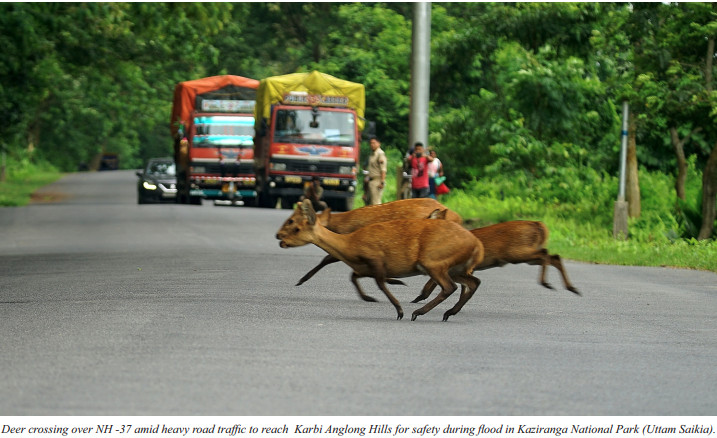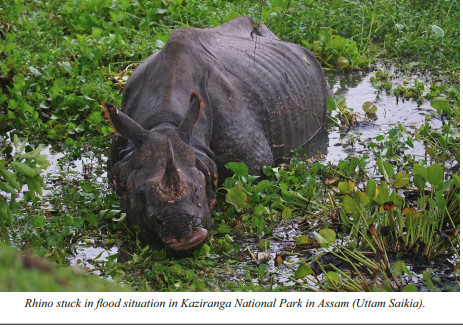By Seema Sharma, a freelance journalist based in Chandigarh, email: [email protected]

The wild animals of Kaziranga National Park and Tiger Reserve (KNPTR) in Assam are having a tough time battling with the deluge these days. More than 120 animals, including 11 rhinos, have died in the flood which has swept over 85% of Kaziranga. According to official sources, two of the rhinos succumbed to natural causes. Full count of animal causalities will be known only after the flood recedes.
The 880 sq. km Kaziranga comprising a core area of 430 sq. km is surrounded by the Brahmaputra on the north and the hills of Karbi Anglong in the south. The annual flood puts immense pressure on these animal species for survival.
KNPTR, a UNESCO World Heritage Site, is proudly the world’s major stronghold of 2400 one-horned rhinos. The park has other impressive animals like about 121 tigers and 1100 Asiatic elephants. It is also home to several globally threatened animal species such as gaur, wild water buffalo, hog deer, and the Hoolock gibbon. Britain’s Prince William and his wife, Kate Middleton, have expressed their concern for the park’s animals in a letter sent to park authorities a few days ago. The couple who had visited the park in 2016 expressed their distress about the flood unleashing havoc to the park and its world famous wildlife.
Flood essential for the ecosystem of the park

However, park authorities and many experts believe floods are also essential for the ecosystem of Kaziranga. “Flood plays a vital role in maintaining the riverine ecosystem of Kaziranga by providing for the essential alluvial deposits from the Brahmaputra and its tributaries.” P Sivakumar, director, KNPTR said. Uttam Saikia, Honorary Wildlife Warden of Kaziranga, reinforced this view saying that floods replenish Kaziranga’s water bodies and maintain its wetlands, grasslands, and deciduous forests as well as stocking up the breeding ground for fish.
Bibhab Kumar Talukdar, chief executive officer of Aaranyak and Asia coordinator of International Rhino Foundation said, “Kaziranga is located in flood plains. Animals have been surviving floods here for over 100 years. Had the floods been too detrimental, the rhinos’ number would have gone down.”
However, he also emphasised that deforestation in catchment areas, water release by dams upstream and climate change is worsening the magnitude of devastation and taking its toll on the unprepared animals. This is the sixth heaviest monsoon in the state in the last 40 years.
Artificial highlands v/s natural hill highland for shelter
Kaziranga authority has created 144 artificial highlands—of which 33 were sanctioned three years back—to provide temporary shelter to the animals during flood and bring down animal casualty during this yearly tragedy. But the reality is that about 70 percent of these highlands are in dilapidated condition. Around 33 new ones have been built in the direction flow, along the southern boundary of Kaziranga.
Talukdar added, “Too many highlands are not good for animals as the erosion and siltation caused by them may affect we t l a n d a n d ma y c h a n g e t h e composition of grasslands. They must be created for short-term and in scientific manner.” “The artificial highland will lead to more erosion, more siltation in the grasslands and wetlands on which rhinos and other multiple animal species are dependent. Karbi Anglong hills are the natural traditional shelter for the animals”, said Rabindra Sharma, research officer with the park.
E r o si o n , m i n i n g , c o r r i d o r bottl ene cks impac ting Karbi Anglong
National Tiger Conservation Authority in their last year’s report had mentioned that this landscape connectivity, crucial for the survival of long-ranging species like the Indian elephants and Bengal t i g e rs is u n d e r t h r e a t f r o m indiscriminate rock mining and quarrying.
“While the southern part of KazirangaK a r b i A n g l o n g l a n d s c a p e is experiencing fast paced urbanisation coupled with destruction of Karbi Anglong hills due to illegal and rampant mining/quarrying activities, the Kaziranga is also facing another na tur a l thr e a t on its northe rn boundary,” the report said. “Every year, the river Brahmaputra is continuously eroding the northern and eastern bank of Kaziranga core.”
R o h i t C h o u d h u r y , w i l d l i f e conservationist said, “It is very unfortunate that due to the disturbance caused in their habitat of Karbi Anglong hills, most of the wildlife like barking deer, hoolock gibbon, rhinos etc have abandoned the area.” In April last year, Supreme court restrained mining and related activities along the Kaziranga National Park area and in the entire catchment area of rivers/streams and rivulets originating in Karbi Anglong Hill ranges and flowing into the Kaziranga. “No new construction shall be permitted on private lands which form part of the nine identified animal corridors,” the bench said. Both Kaziranga and Karbi Anglong Hills make an area of 25,000-squarekilometer (9,650-square-mile)as Kaziranga-Karbi Anglong Landscape. Kaziranga and Karbi Anglong were part of the same landscape in the past. Nine wildlife corridors — Panbari, H a l d i b a ri , Ba g o ri , H a r m a t i , Kanchanjuri, Hatidandi, Deosur, Chirang and Amguri — have been badly disrupted with the construction of expanded infrastructure like resorts and National Highway 37.
Around 17 animals were killed by speeding traffic during last year’s flood, according to the flood report of forest department. The district administration has imposed a speed limit of 40 km/hr to avoid animal getting killed in road accident. Despite this, around 15 hog deer besides other animals have been crushed by the speeding vehicles, this year. “
A flyover will be built over NH-37 to divert the traffic on it to permit animals to cross the road without any difficulty. The project may take a decade to complete,” said Sharma.
New plans to facilitate intrusion-free movement of animals
According to Sivakumar, the park administration is mindful of managing corridor issue including those cutting a c r o ss N H – 3 7 . H e s a i d t h a t management will develop three new corridors on 500hectares of land in near future. He further added, “This year, the Centre approved and sanctioned a fund of Rs 12.5 crore for a highland and road project that will raise the heights of some of the low roads in the national park to the level of the existing touristcircuit road. These new additions are meant to give relief to the animals during floods while the heightened roads will be used for patrolling by the forest staff.” The officials contended that they have heightened the patrolling to ensure protection of vulnerable animals from poaching during flood time.
Community support for animals
Parimal Suklabaidya, minister of environment and forest said, “The forest department is facing a double whammy of protecting the animals in Kaziranga every year, one from poachers and other from natural calamities. The forest department and the government are making all efforts to protect the animals even at Karbi Anglong”. Saikia talked about community awareness of wildlife rescue. “Regular a w a r e n e ss p r o g r amme s w e r e conducted in the nearby villages with regard to saving and rescuing the animals during flood situation. Dr. Rathin Barman, Joint Director, Wildlife Trust of India, chipped on this subject saying that the support they are getting from the community in rescue operations is enormous.
